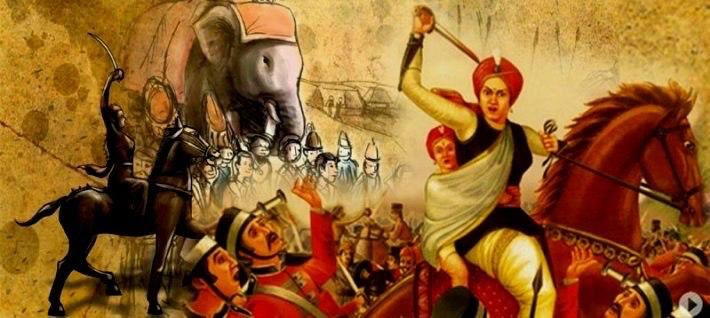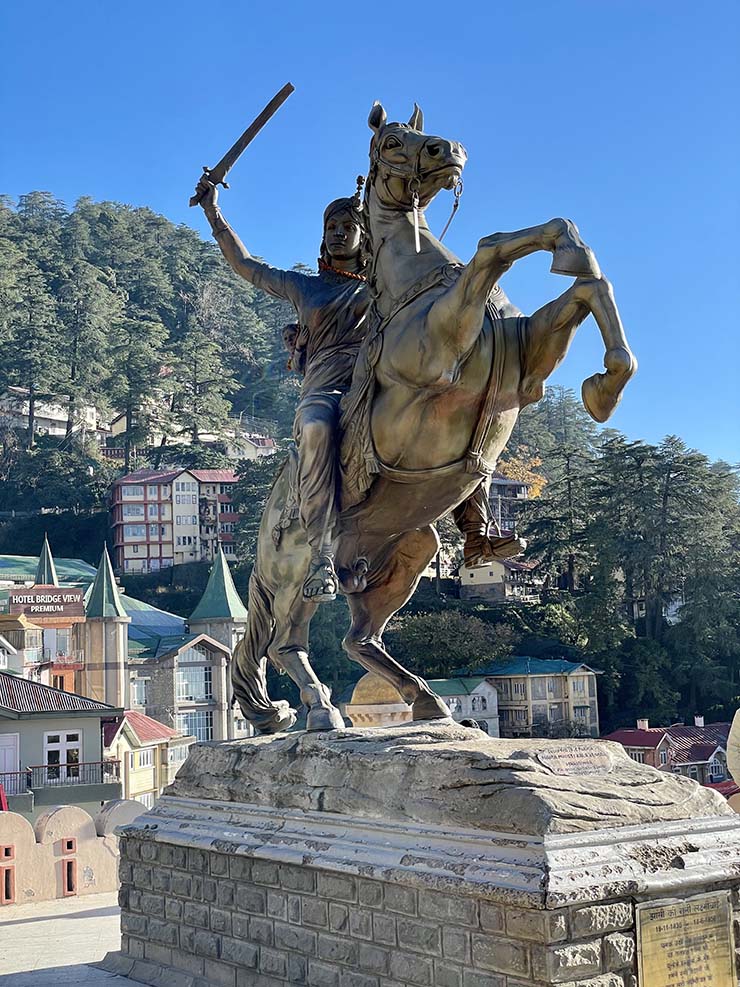
Popularly known as Jhansi ki Rani, Lakshmi Bai was one of the prominent leaders of the country’s First War of Independence against the British in 1857-58. She died fighting the British forces at the age of 23 with her name etched in history as one of the bravest women warriors of the country. She was born in Varanasi on November 19 in 1835, and she died on June 17 in 1858 at Kotah-ki-Serai near Gwalior fighting the British.
“We will fight for independence. In the words of Lord Krishna, we will enjoy the fruits of victory if we are victorious. If defeated and killed on the battlefield, we shall surely earn eternal glory and salvation,” says Lakshmi Bai.
Lakshmi Bai belonged to a Marathi Karhade Brahmin family and was named Manikarnika Tambe with the nickname Manu. She was only four years old when her mother died. Her father was the commander of the Kalyanpranth war and worked for Peshwa Baji Rao II in the Bithoor district.
Lakshmi Bai grew up in the household of the Peshwa (ruler), who called her Chhabili, which means beautiful. It was an unusual upbringing for a Brahmin girl. She was educated at home and received training in martial arts, and she became proficient in sword fighting and riding. Unlike other girls of her age, she was independent, she learned shooting, fencing and mallakhamba with boys, including her childhood friends Nana Sahib and Tantia Tope.
Victim of the Doctrine of Lapse
Lakshmi Bai was married to the maharaja of Jhansi, Gangadhar Rao, but was widowed without bearing a surviving heir to the throne. Following the established Hindu tradition, the maharaja just before his death adopted a boy as his heir. But the British governor-general Lord Dalhousie refused to recognise the adopted heir and ordered to annex Jhansi in accordance with the Doctrine of Lapse.
The 22-year-old queen refused to cede Jhansi to the British. She was proclaimed the Regent of Jhansi, and she ruled on behalf of the minor heir. Under her rule, Jhansi was a peaceful place. It was relatively calm in the midst of the regional unrest in the summer of 1857. She conducted a Haldi Kumkum ceremony with pomp in front of all the women of Jhansi to provide assurance to her subjects, and to convince them that the British were cowards and not to be afraid of them.
Tantia Tope and Lakshmi Bai mounted a successful assault on the city-fortress of Gwalior. The treasury and arsenal were seized, and Nana Sahib, a prominent leader, was proclaimed the Peshwa.
The British announced that troops would be sent to control the area but the fact that none arrived strengthened the position of Rani’s advisers who wanted independence from the British rule. When the British forces finally arrived, they found Jhansi well-defended. The fort had heavy guns, which could fire over the town and nearby countryside. General Hugh Rose, commanding the British forces, demanded the surrender of the city, warning that if the order was refused it would be destroyed.
Rani issues proclamation
Rani Lakshmi Bai issued a proclamation: “We will fight for independence. In the words of Lord Krishna, we will enjoy the fruits of victory if we are victorious. If defeated and killed on the battlefield, we shall surely earn eternal glory and salvation.” She defended Jhansi against British troops when General Rose besieged Jhansi on March 23, 1858.
Lakshmi Bai rapidly organised her troops and assumed charge of the rebels in the Bundelkhand region. Mutineers in the neighbouring areas headed towards Jhansi to offer her support. An army of more than 20,000 troops headed by Tantia Tope was sent to defend Jhansi.
General Rose began the offensive in Bundelkhand in January 1858. Advancing from Mhow, General Rose captured Saugor (now Sagar) in February and then turned towards Jhansi in March. The company’s forces surrounded the fort of Jhansi, and a fierce battle raged. Offering stiff resistance to the invading forces, Lakshmi Bai did not surrender even after her troops were overwhelmed and the rescuing army of Tantia Tope was defeated at the Battle of Betwa. Lakshmi Bai managed to escape from the fort with a small force of palace guards and headed eastward where other rebels joined her.
Assault on Gwalior fort
 Tantia Tope and Lakshmi Bai mounted a successful assault on the city-fortress of Gwalior. The treasury and the arsenal were seized, and Nana Sahib, a prominent leader, was proclaimed the Peshwa. After taking Gwalior, Lakshmi Bai marched east to Morar to confront a British counterattack led by General Rose. She fought dressed as a man.
Tantia Tope and Lakshmi Bai mounted a successful assault on the city-fortress of Gwalior. The treasury and the arsenal were seized, and Nana Sahib, a prominent leader, was proclaimed the Peshwa. After taking Gwalior, Lakshmi Bai marched east to Morar to confront a British counterattack led by General Rose. She fought dressed as a man.
During the battle with Tantia Tope’s forces, part of the British forces continued the siege and by April 2 it was decided to launch an assault by a breach in the walls. Determined resistance was encountered in every street and in every room of the palace. Street fighting continued into the following day and no quarter was given, even to women and children.
The Rani withdrew from the fort and went to Kalpi with a few guards, where she joined additional rebel forces, including Tantia Tope. They occupied the town of Kalpi. On May 22, the British forces attacked Kalpi; the forces were commanded by the Rani herself.
Last battle dressed as a cavalry leader
On June 17 in Kotah-ki-Serai near the Phool Bagh of Gwalior, a squadron of the 8th (King’s Royal Irish) Hussars, under Captain Heneage, fought the large Indian force commanded by the Rani, who was trying to leave the area. The 8th Hussars charged into the Indian force, slaughtering 5000 Indian soldiers, including any Indian ‘over the age of 16’.
Rani Lakshmi Bai in a sowar’s uniform attacked one of the hussars, but she was unhorsed and wounded, probably by his sabre. As she sat bleeding, she fired the soldier with a pistol, whereupon he ‘dispatched the young lady with his carbine’. According to another story, Lakshmi Bai, dressed as a cavalry leader, was badly wounded. She asked a hermit to burn her body after her death as she did not want the British to capture it. She was cremated by the locals.
Rani Mahal, the palace of Lakshmi Bai, has been converted into a museum. It houses a collection of archaeological remains from the 9th century onwards.
– The writer is a senior journalist and media consultant. The views expressed are of the writer and do not necessarily reflect the views of Raksha Anirveda








